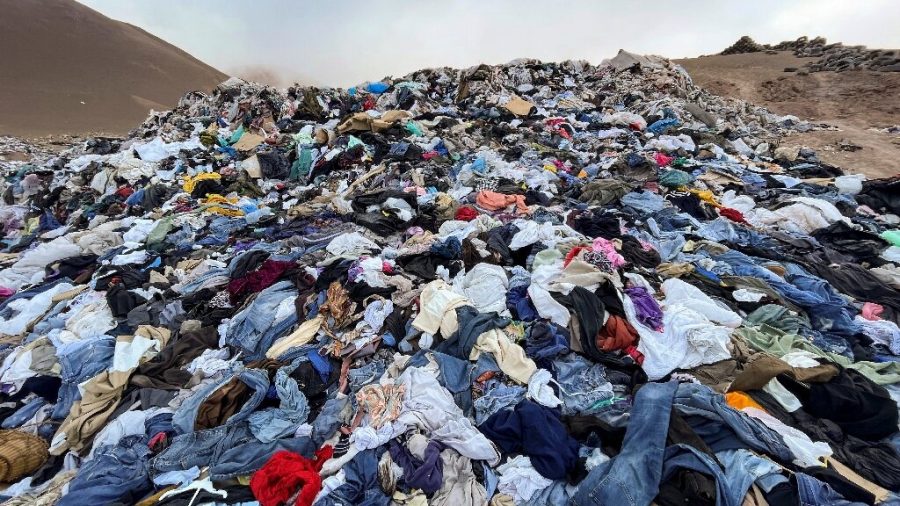Fast fashion: destroying our planet
Dumping grounds of unusable fast fashion in Chile’s Atacama Desert
Fast fashion—from H&M and Zara to Shein and Stradivarius, their garments, shoes and accessories are an integral part of closets, trends and challenges across the world. Fast fashion is stylish, affordable and convenient. According to BusinessWire, the global fast fashion industry has been valued at $30 billion USD, a 21% jump from last year’s $25.09 billion USD evaluation and will only continue to grow within the next decade. As the fast fashion industry continues to evolve, human and animal rights abuses, environmental concerns and quality issues have become the forefront of discussion within and outside of the fashion realm. Can the industry continue to operate in this manner and exercise sustainable practices or will long-awaited reform and change have to take place once and for all?
In order to understand what fast fashion is and how it came to be, we need to take a look at the history of fashion. Prior to the 18th century, manufacturing clothes was a lengthy process. Clothing makers had to source, prepare, weave, stitch and paint fabric—a process that could take days or weeks to complete. The labor that went into fashion made it only feasible to plan small lines months or years in advance with limited stock. However, as advancements in technology struck the west through the industrial revolution in 1760, fashion as the world knew it would change. Sourcing, preparing, weaving, stitching and painting fabric, a process that would normally take days or weeks to complete, could now be finished in hours. During this time, a middle class emerged—a middle class eager to earn and spend their newfound money. Clothing makers and businesses could now pump out garments, shoes and accessories at the fastest speed up to this point in human history, and from there the cycle began. In today’s day and age, it is now possible to purchase numerous styles and collections of clothes from hundreds of stores in hundreds of colors, materials and prices. However, the ethicality of the process that goes into our fashion isn’t as good as it seems.
Fast fashion is a large contributor to human rights abuse globally. Companies such as Zara, Fashion Nova and Forever 21 rely heavily on sweatshops and cramped garment factories for cheap and fast labor. According to Borgen Magazine, many of these facilities are located in poor nations such as Bangladesh, Vietnam, China and Indonesia. Workers—over 80% women as reported by Forbes—are forced to work long, gruesome hours without breaks in poor conditions with minimal pay. Conditions and upkeep in these facilities can get so poor that factory collapses are a frequent occurrence, including the infamous 2013 Rana Plaza incident which according to the International Labour Organization, resulted in the death of over 1,100 garment workers. Since the Rana Plaza incident, over 109 other incidents of this magnitude occurred in Bangladesh alone. The abuses do not only affect humans but extend to animals as well. Many fashion brands use animal skin, wool, feathers and animal by-products in many of their garments as well as during their production. Animals are slain in cruel manners and forced to live in poor conditions due to a lack of regulation within fashion in regards to animal use and treatment.
Fast fashion is also a large contributor to environmental pollution of our air, forests, land and waterways. Because of the low costs and high availability of fast fashion across the world, consumers are throwing out as much clothing as they’re buying. According to the Princeton Student Climate Initiative, In 2019 alone, over 62 million tonnes of apparel was consumed. Although purchasing clothing is beneficial to our economy, it isn’t as good for our environment, as over 57% of all clothing discarded ends up in landfills and incinerators. Another pressing environmental issue within fashion is the use of synthetic materials such as Viscose. Viscose—widely known as rayon—is a type of synthetic fabric that is used across all sectors of fashion. The issue with the use of Viscose is its harmful effects on the environment such as the use of toxic and detrimental chemicals to produce the textile—so toxic in fact that workers who produce Viscose fabric are prone to lethal side effects when incinerated, Viscose releases more emissions than cotton products. Synthetic textiles are also a big component of microplastic pollution with over 35% of all microplastics originating from synthetic textiles. Microplastics are detrimental to the environment, polluting our oceans, our food and causing thousands of deaths each year. Fashion also has high water usage with an astounding one tenth of yearly water consumption that can be tied back to fashion products and manufacturing. It takes over 3,000 liters or 793 gallons of water to produce one cotton shirt and 10,000 liters or 2642 gallons of water to produce one kilogram (2.2 pounds) of cotton. To put this in perspective, according to Aquasana, the average American uses 3,000 gallons of water per month—the amount of water it takes to produce around five cotton shirts or a little over one kilogram (2.2 pounds) of cotton. And this is only the beginning of the environmental impact that fashion has on our world. High emissions production, deforestation and chemical waste are other problems that plague fashion.
Fast fashion is also plagued with quality issues. From poor quality stitching to easy-to-tear fabrics, fast fashion is built off of a model of clothing that only lasts one season so consumers can go and buy new in-style fashions in a matter of weeks. Textiles like polyester, nylon, rayon and spandex are brittle and not meant for regular use. Another issue according to The Pretty Planeteer Magazine is the thickness of the fabrics, which are up to 75% thinner than traditional clothing, making them weak and of low quality. Ultimately, the issue of fast fashion comes down to consumer behavior. People want cheap clothing that is in style and as long as we keep the demand for fast fashion up, companies will not be incentivized to change their harmful and abusive ways.
Some may say that the affordability of fast fashion outweighs all of the cons, however, this is not true. Although you may save initially when you consume fast fashion, the quality of the clothing will constantly keep you in the store, purchasing new clothing multiple times a month for when your seven-dollar shirt and five-dollar jeans rip, and that cost can certainly add up. Additionally, it is not worth the effects on our environment and the human rights abuses committed by many of these companies for clothing that may be cheaper but won’t last long in our closet.
The only way that we can stop this and demand industry-wide reform is if we change our habits. Companies won’t cease their predatory and dangerous practices unless we as consumers demand change. Until that happens, there is no telling what fast fashion could morph into and how much more it could damage our environment, our pockets and our society for generations to come.








